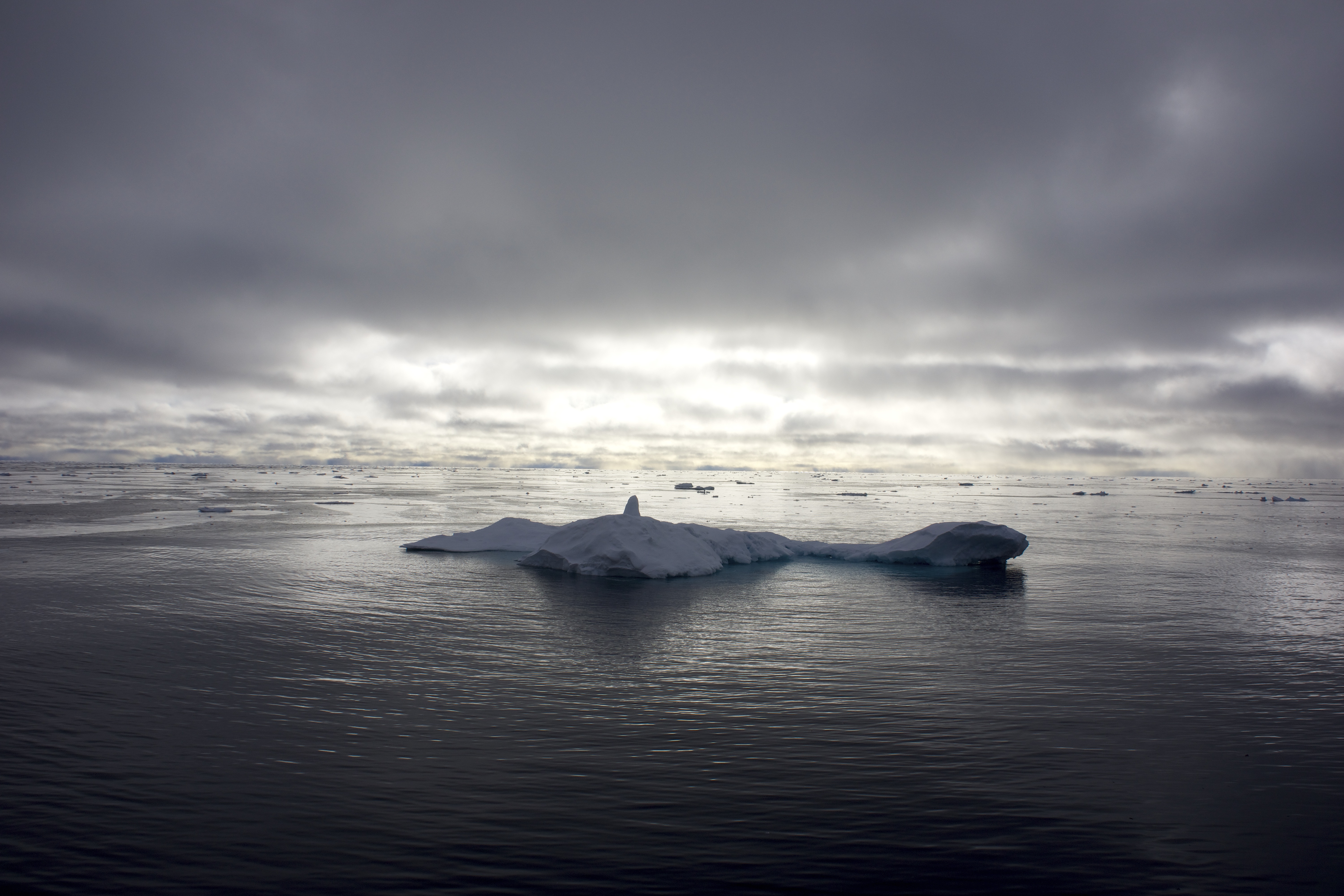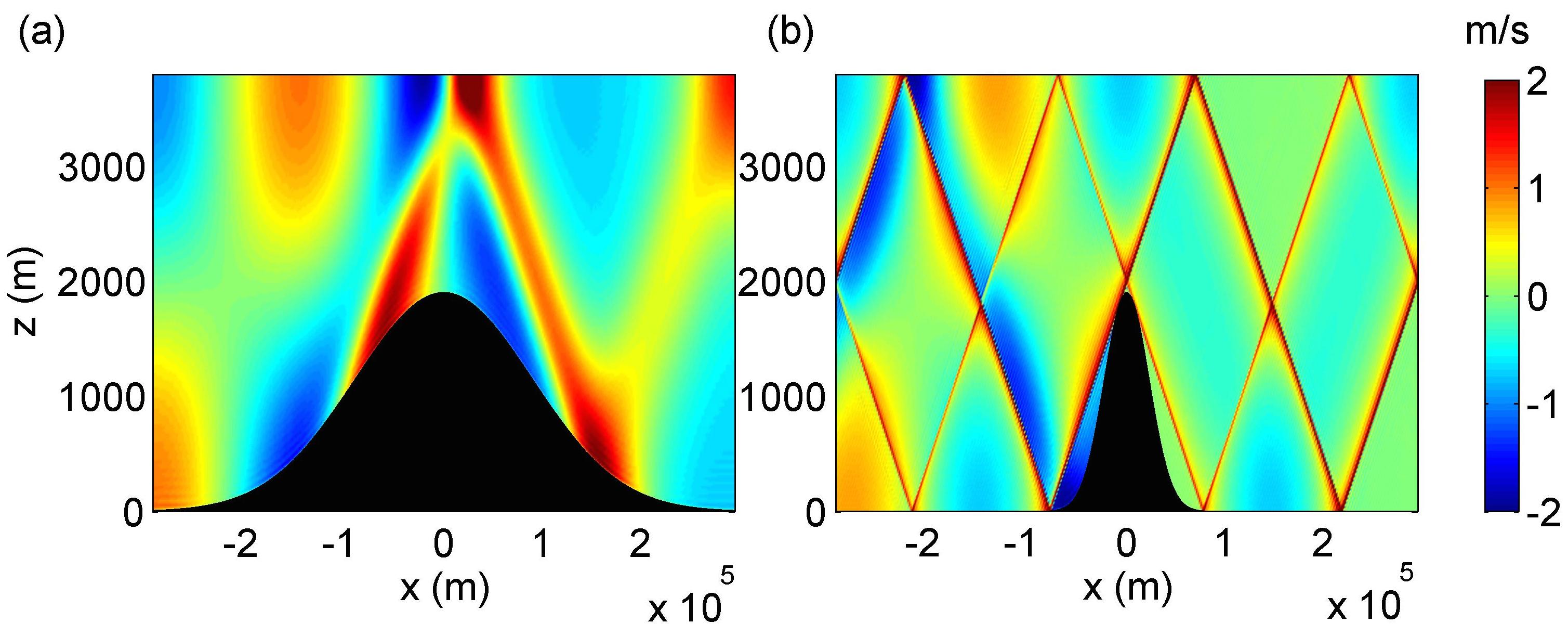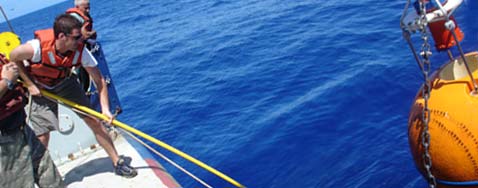Research > Internal Waves
Internal waves are propagating disturbances of gravitationally-stable density stratifications. They are ubiquitous in the Earth's oceans (and also atmosphere), where they are generated by flow over ocean-floor topography and sea-surface winds. Dissipation of these internal waves impacts the Earth's climate by influencing large-scale ocean circulation, affecting plankton distribution, and perhaps even shaping the continental slopes. From an engineering perspective, internal waves affect the performance of underwater technology, such as acoustic communication, submersible vehicles and marine cabling. A detailed understanding of all aspects of internal wave generation and evolution is therefore both profoundly and practically important.
We are currently using the latest experimental and theoretical techniques to investigate important aspects of the tidal conversion process, as well as collaborating with numerical simulations. In addition, we participate in ocean-going studies, such as the recent IWAP cruise off Hawaii and the ONR NLIWI field studies in the Luzon Strait. Our internal wave research is funded by the ONR and the NSF Physical Oceanography program.
Spotlight
The formation and fate of internal waves in the South China Sea
For over a decade, studies have targeted the South China Sea, where the oceans’ most powerful known internal waves are generated in the Luzon Strait and steepen dramatically as they propagate west. Confusion has persisted regarding their mechanism of generation, variability and energy budget, however, owing to the lack of in situ data from the Luzon Strait, where extreme flow conditions make measurements difficult. Findings from the ONR IWSIE team give a cradle-to-grave picture of internal waves on a basin scale, which will support further improvements of their representation in numerical climate predictions. A detailed report of this study has been published in Nature.
Spotlight

Arctic Ocean layering
Given the ubiquity of layering in environmental stratifications, an interesting example being double-diffusive staircase structures in the Arctic Ocean, we have obtained exciting new results from a joint theoretical and laboratory experimental study investigating the impact of multiple layering on internal wave propagation. Results for a simplified model demonstrate the nontrivial impact of multiple layering, and utilizing a weakly viscous, linear model that can handle arbitrary vertical stratifications, we have performed a direct comparison of theory with experiments. The model has been applied to a case study of a staircase stratification problem obtained from the Arctic Ocean, showing a rich landscape of transmission behavior. A detailed report of this study is in revision in the Journal of Fluid Mechanics.
Spotlight

Topographic scattering of the low-mode internal tide in the deep ocean
We investigate the role of deep-ocean topography in scattering energy from the large spatial scales of the low-mode internal tide to the smaller spatial scales of higher modes. The complete Green function method, which is not subject to the restrictions of the WKB approximation, is used for the first time to study the two-dimensional scattering of a mode-1 internal tide incident on subcritical and supercritical topography of any form in arbitrary stratifications. A significant finding is that compared to large extents of small-amplitude, rough topography a single large topographic feature along the path of a mode-1 internal tide plays the dominant role in scattering the internal tide. A detailed report of this study has been published in the Journal of Geophysical Research: Oceans.
Relevant Publications
- Peacock, T., and Weidman, P., "The effect of rotation on conical wave beams in a stratified fluid," Experiments in Fluids, 39, 32-37 (2005). [link]
- Peacock, T. and Tabaei, A., "Visualization of nonlinear effects in internal wave beam reflection," Physics of Fluids, 17, Art. No. 061702 (2005). [link]
- Alford, M. H., MacKinnon, J.A., Zhao, Z., Pinkel, R., Klymak, J. and Peacock, T., "Internal waves across the Pacific," Geophysical Research Letters 34 (24), L24601 (2007). [link]
- Peacock, T., Echeverri, P. and Balmforth, N. J., "Experimental investigation of internal tide generation by two-dimensional topography," Journal of Physical Oceanography, 38 (1), 235-242 (2008). [link]
- Balmforth, N. J. and Peacock, T., "Internal tide generation by supercritical topography," Journal of Physical Oceanography, 39, 1965-1974 (2009). [link]
- Echeverri, P., Flynn, M. R., Winters, K.B. and Peacock, T., "Low-mode internal tide generation: an experimental and numerical investigation," Journal of Fluid Mechanics, 636, 91-108 (2009). [link]
- Mathur, M. and Peacock, T., "Internal wave beam propagation in nonuniform stratifications," Journal of Fluid Mechanics, 639, 133-152 (2009). [link]
- Echeverrri, P. and Peacock, T., "Internal tide generation by arbitrary two-dimensional topography," Journal of Fluid Mechanics, 659, 247 (2010). [link]
- Mercier, M. J., Martinand, D., Mathur, M., Gostiaux, L., Peacock, T. and Dauxois, T., "New wave generation," Journal of Fluid Mechanics, 657, 308 (2010). [link]
- Peacock, T., Mercier, M. J., Didelle, H., Viboud, S. and Dauxois, T., "A laboratory study of low-mode internal tide scattering by finite-amplitude topography," Physics of Fluids, 21, 121702(2010). [link]
- Tang, W. E. and Peacock, T., "Lagrangian coherent structures and internal wave attractors," CHAOS, 20, 017508 (2010). [link]
- Mathur, M. and Peacock, T., "Internal wave interferometery," Physical Review Letters, 104, 118501 (2010). [link]
- Echeverri, P., Yokossi, T., Balmforth, N.J. and Peacock, T., "Internal Tide Attractors Between Double Ridges," Journal of Fluid Mechanics, 669, 354-374 (2011). [link]
- Ghaemsaidi, S. J. and Peacock, T., "3D Stereoscopic PIV visualization of the axisymmetric conical internal wave field generated by an oscillating sphere," Experiments in Fluids, 54, 1454 (2013). [link]
- Mercier, M. J., Gostiaux, L., Helfrich, K., Sommeria, J., Viboud, S., Didelle, H., Ghaemsaidi, S. J., Dauxois, T., & Peacock T., "Large–scale, realistic laboratory modeling of M2 internal tide generation at the Luzon Strait" Geophysical Research Letters, 40, 1-6 (2013). [link]
- Mathur, M., Carter, G. and Peacock, T., "Topographic scattering of the low-mode internal tide in the deep ocean", Journal of Geophysical Research: Oceans, 119, 2165-2182 (2014). [link]
- Ouazzani, Z., Hacker, J., Thompson, R. and Peacock, T., "The Morning Glory: flow visualization by Mother Nature", Physics of Fluids, 26, 091110 (2014). [link]
- Alford, M. H., Peacock, T., MacKinnon, J. A., et al., "The formation and fate of internal waves in the South China Sea", Nature, 521, 65–69 (2015). [link]
- Ghaemsaidi, S.J., Dosser, H., Rainville, L. & Peacock, T., "The impact of layering on internal wave transmission", Journal of Fluid Mechanics, accepted. [link]
- Ghaemsaidi, S. J., Joubaud, S., Dauxois, T., Odier, P. and Peacock, T., "Nonlinear internal wave penetration via parameteric subharmonic instability", Physics of Fluids, accepted. [link]
- Mathur, M., Carter, G.S. and Peacock, T., "Internal tide generation using Green function analysis: to WKB or not to WKB?", in review. [link]
People
- Thomas Peacock
Professor - Ruth Musgrave
Postdoc - Rohit Supekar
Graduate Student - Boyu Fan
Graduate Student - Sasan John Ghaemsaidi
Collaborator - Hayley Dosser
Collaborator, Yale University - Magdalena Andreas
Collaborator, WHOI - Jae Hun Park
Collaborator, INHA, Korea - Luc Rainville
Collaborator, University of Washington - Matthew Alford
Collaborator, University of Washington - Neil Balmforth
Collaborator, UBC - Glenn Carter
Collaborator, University of Hawaii - Thierry Dauxois
Collaborator, ENS de Lyon - Shaun Johnston
Collaborator, Scripps - Sylvain Joubaud
Collaborator, ENS de Lyon - Manikandan Mathur
Collaborator, IIT - Philippe Odier
Collaborator, ENS de Lyon - Kraig Winters
Collaborator, Scripps - Matthieu Mercier
Collaborator, IMFT - Maha Haji
Ph.D. Candidate (MIT-WHOI Joint Program) - Matthieu Leclair
Research Engineer, ETH Zürich




